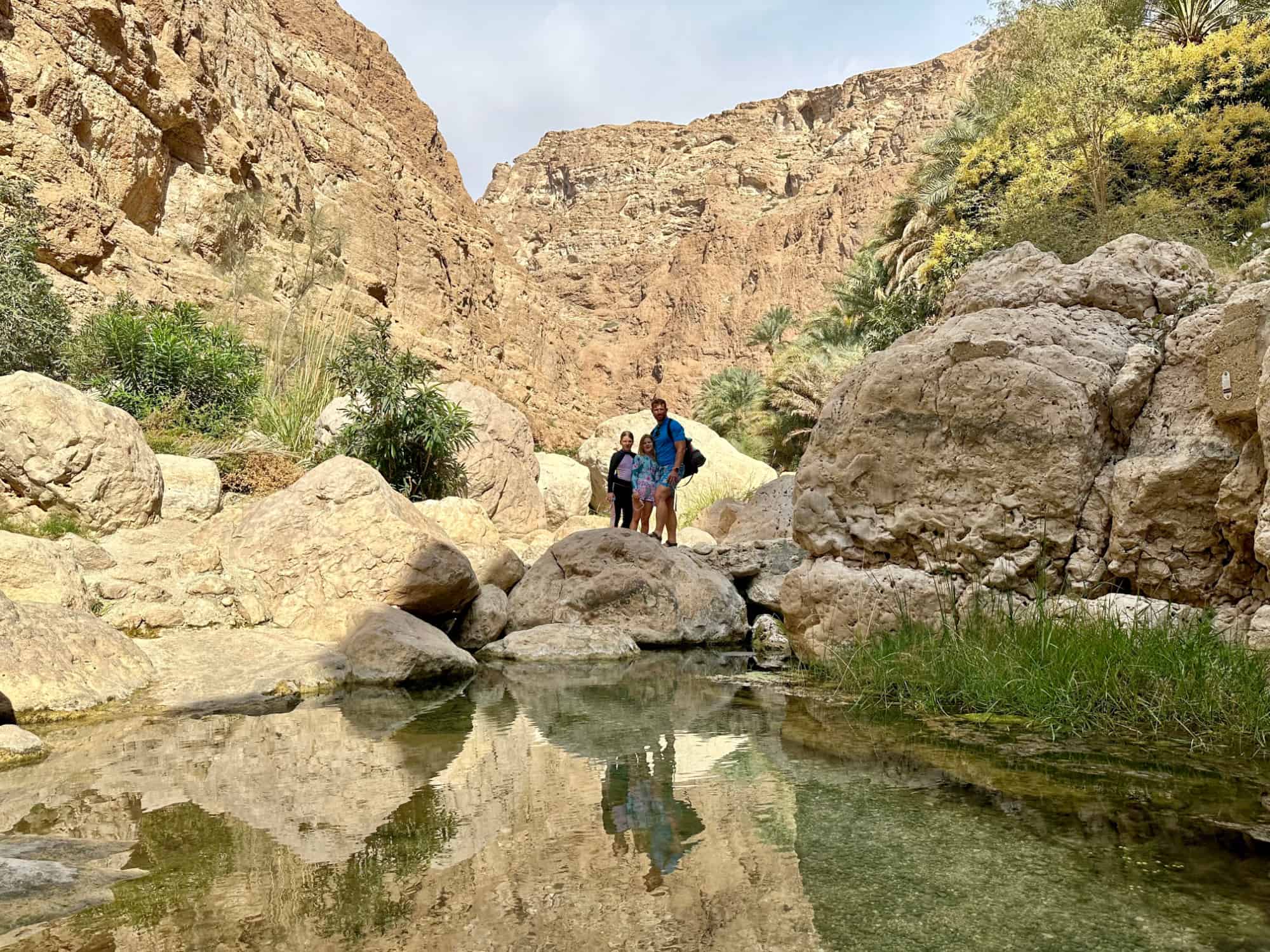Call me cynical but when I hear somewhere described as a ‘must-visit’ I immediately lower my expectations. This is what I did before our visit to Wadi Shab – one of the most popular wadi day trips from Muscat in Oman.
Wadi Shab has been mentioned to us countless times since we moved to Oman. So I was intrigued, especially after getting more of a wadi experience than we bargained for at neighbouring Wadi Tiwi in January.
But I was also ready to be disappointed after visiting the equally lauded but very commercial Wadi Bani Khalid a few weeks before.
So, was it a waste of time? Did we bite off more than we could chew visiting with kids? Or did we have a brilliant time?
In this post I’m going to share our experience of visiting Wadi Shab with our children along with some tips for doing it yourself.
*This post contains affiliate links*
Why visit Wadi Shab?
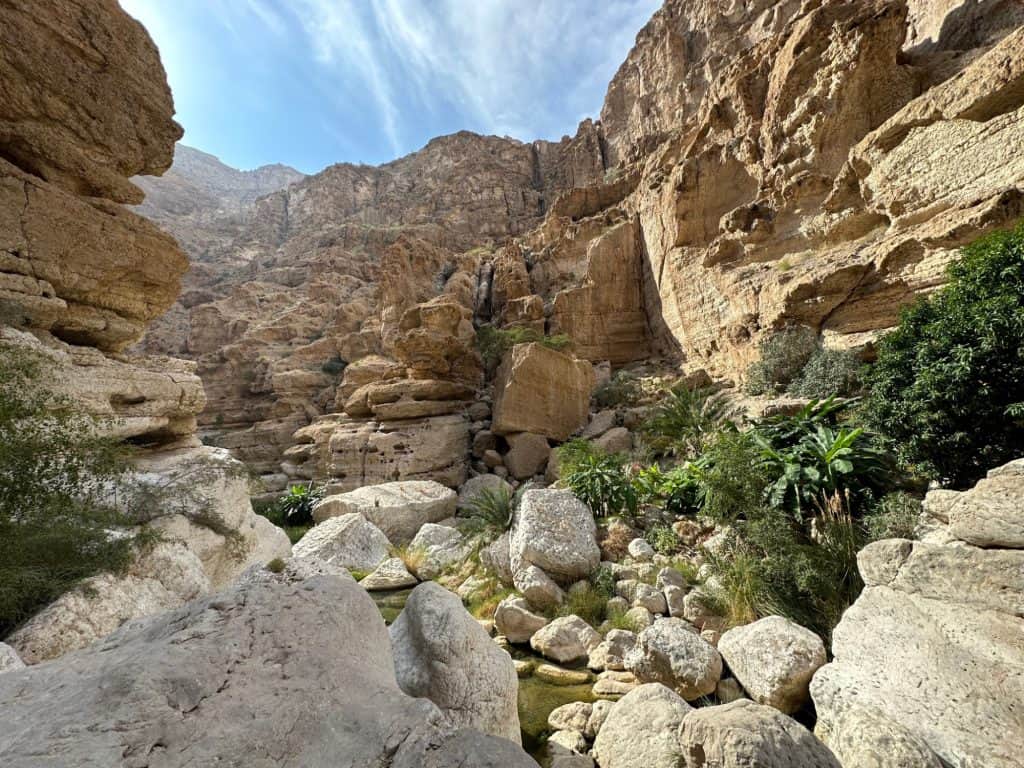
Wadi Shab is an easy day trip from Muscat – about one and a half hours from the city centre by road – and has been set up for tourists, albeit in a very light touch way.
Don’t expect lots of safety measures or flashy facilities, but do come ready to experience Oman’s extraordinary natural beauty.
Your visit will include a boat trip across the wadi entrance, skyscraper gorge walls, a fun hike, long clear pools and a cave you can swim inside to find a hidden waterfall.
We spent three hours exploring and all agreed that it was time well spent.
Here’s our guide to visiting Wadi Shab with children along with some tips for doing it yourself.
Best time to visit Wadi Shab
We visited the wadi on a Saturday in March – a potentially busy time during the winter season when lots of people holiday in Oman.
So we decided to get up early, and get to the wadi before the rush and the heat of midday.

When we arrived at 8.30am there were just a handful of other cars in the car park under Highway 17. The ferry only starts running from 8am so there’s not much point in arriving earlier than this.
By the time we returned three hours later the car park was full, and cars and coaches were parked along the road.
People were still arriving and we passed lots coming in to the wadi as we left.
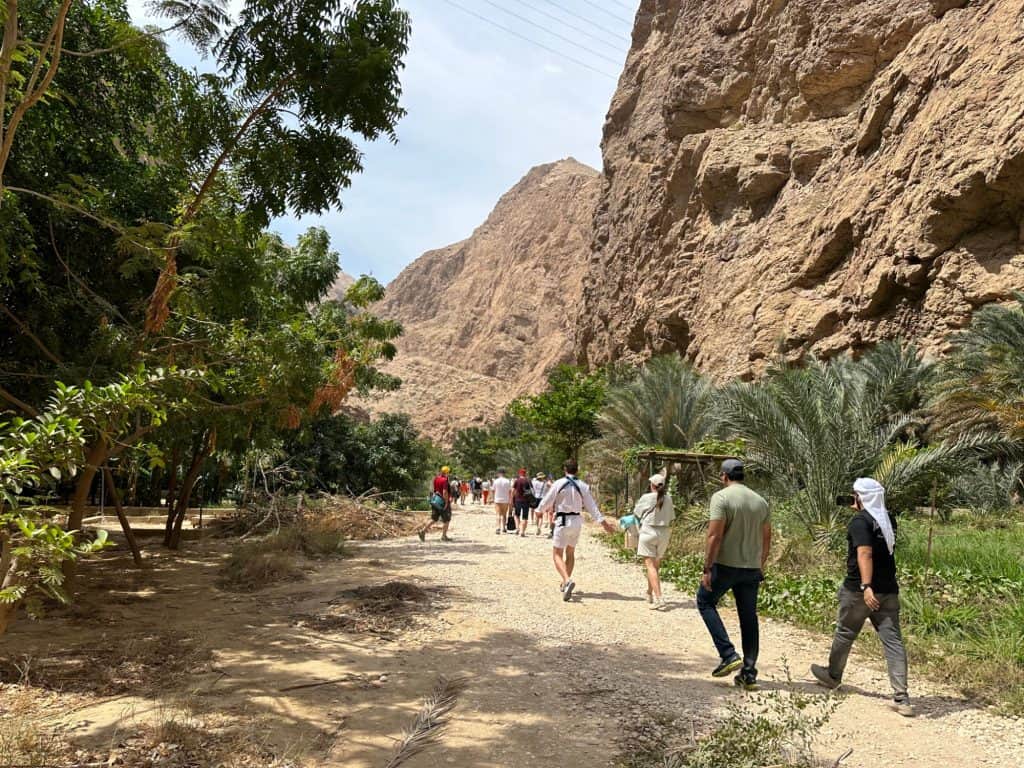
The number of people later in the morning made the hike a little less pleasant on some of the narrower sections with a long drop.
I don’t believe it would be possible to avoid the two way hiking traffic until after 2pm on a weekend. So we were glad we arrived at the start of the day to go with the flow in at least one direction.
If you do decide to visit later on be aware that the wadi is not accessible after late afternoon (see ferry times below). 2pm is probably the latest you want to arrive, particularly if you intend to swim in the pools at the end and visit the cave.
The optimum days to visit are from Sunday to Thursday when there will be fewer locals, like us.
Ferry boat at Wadi Shab
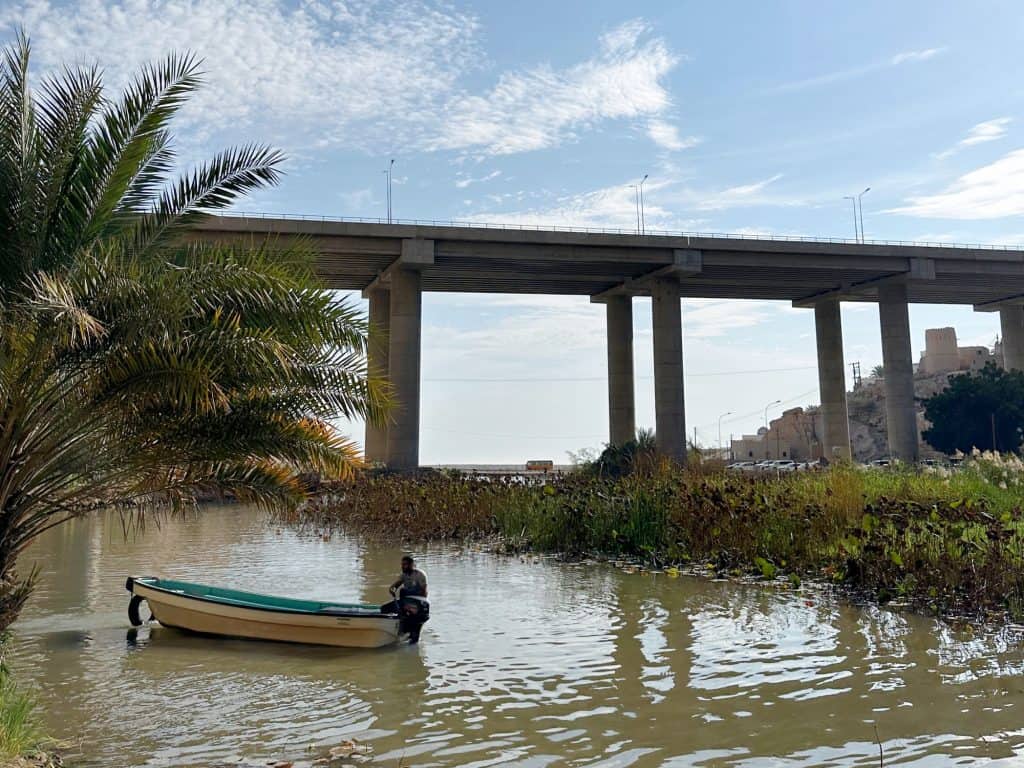
This is the only wadi in Oman where we have had to take a ferry to explore. On the day we visited there were two small motorboats running from the car park.
They take you on a short crossing, under the viaduct to where the wadi path starts on the other side.
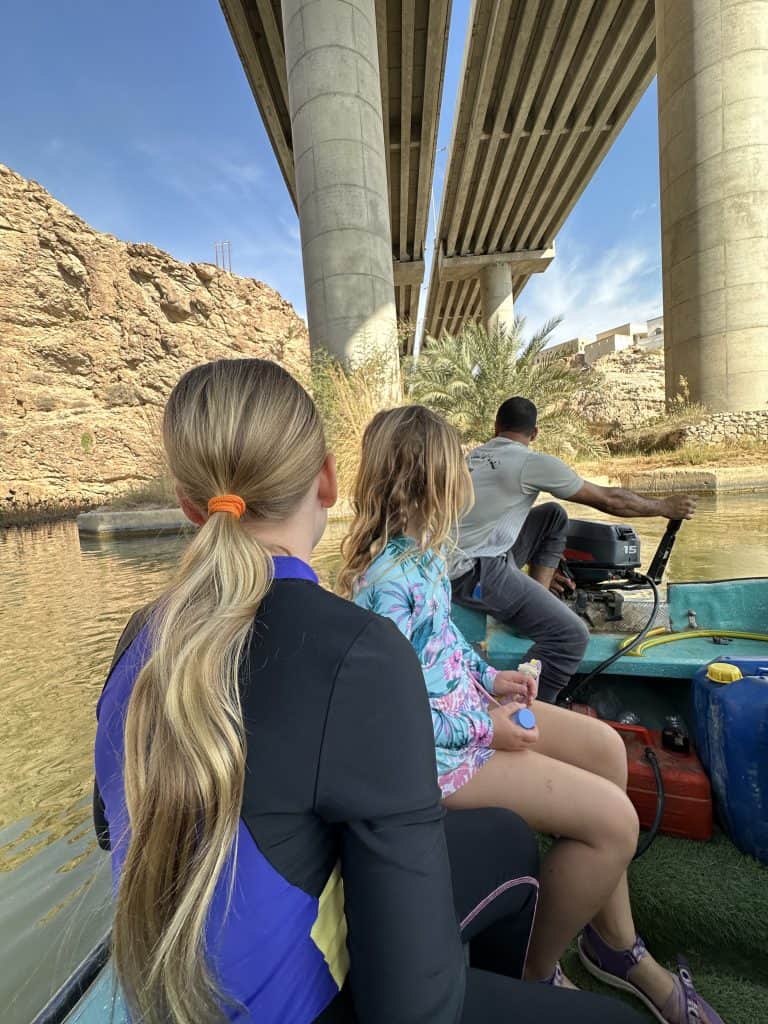

The cost of a return trip is 1 OMR per person, but we were charged 500 baisa (half a rial) for the children. You pay this upfront in cash.
The ferries run daily from 8am, so this is the earliest you can visit Wadi Shab.
The last ferry runs between 5pm and 6pm depending on the season. If you are visiting in the afternoon check when the ferry stops as you will be stranded without it.
The hike into Wadi Shab
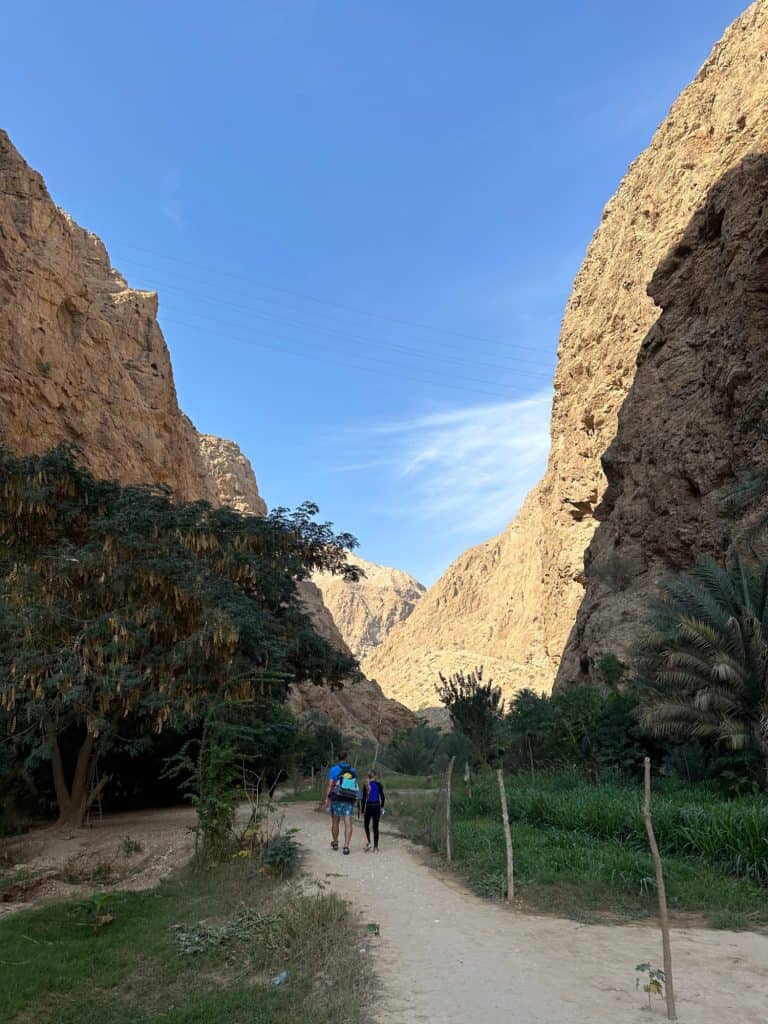
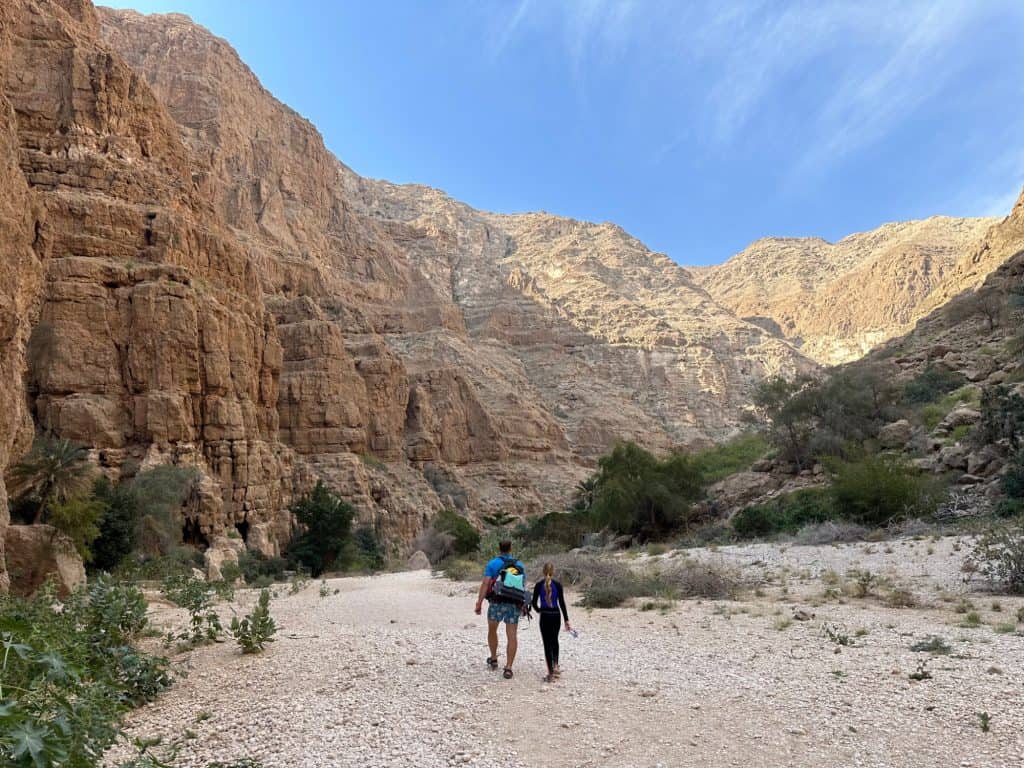
About 15 minutes into the walk the path turns from dust and shingle into rock. Be very careful on the slippery rocks which have been polished by thousands of pairs of feet.
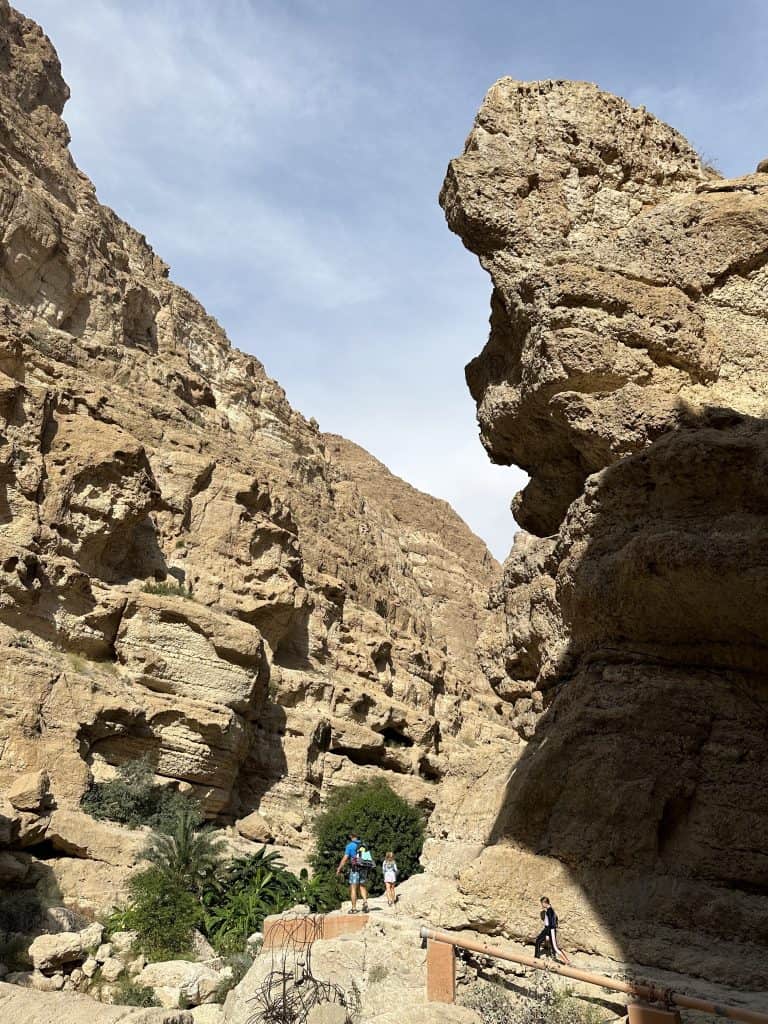
The path has been improved for visitors with most cracks in the rock cemented over but you still need to watch your step, especially as the route starts to rise along the side of the wadi.
There’s no hand rail between you and some big drops. If you are visiting with young children you will need to hold their hands so you know where they are at all times.
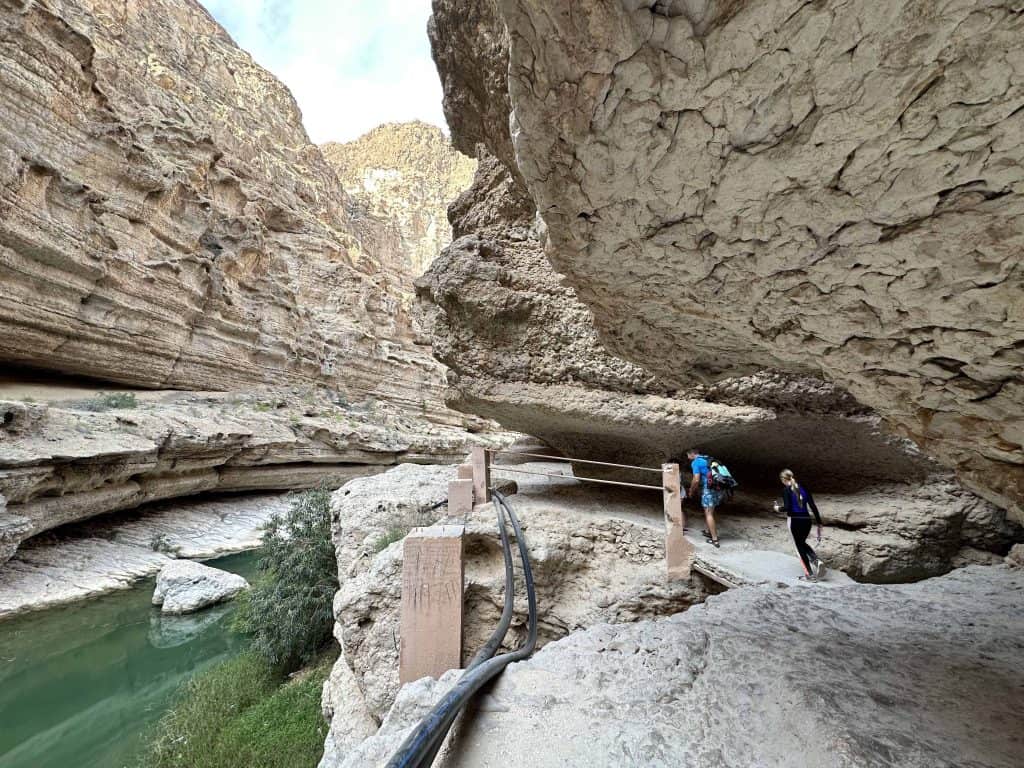
It’s at this point that you see the first section of turquoise water below. It might look inviting but this part isn’t for swimming. There’s no easy way to enter and exit it – another reason to keep hold of little ones.
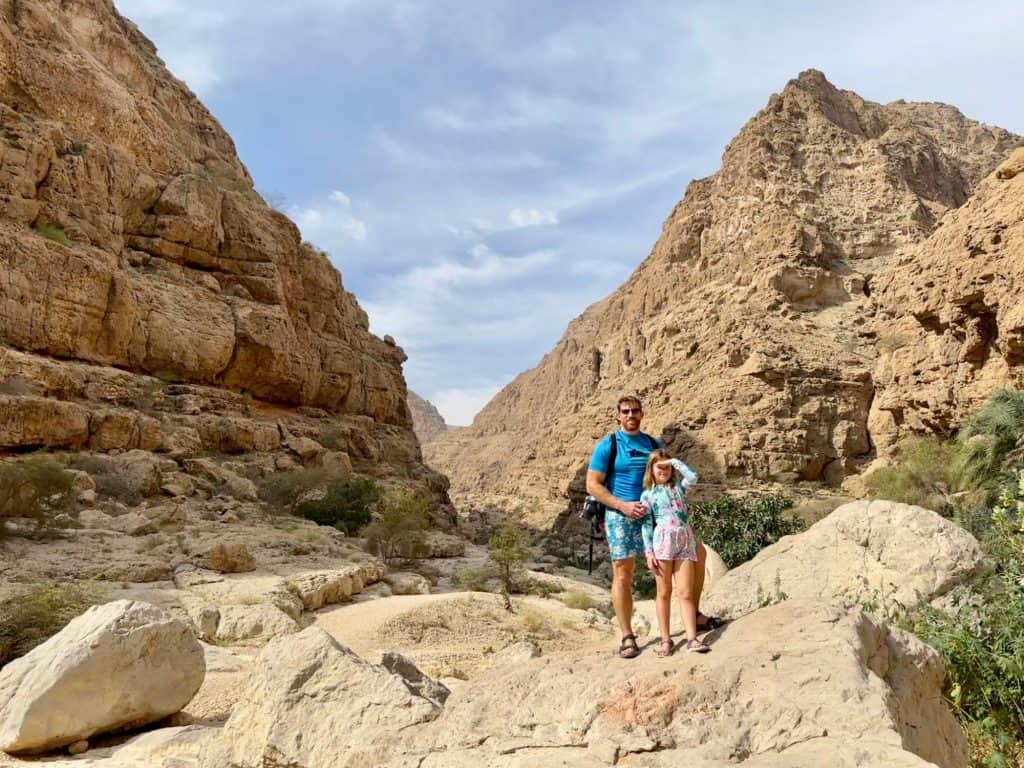
About 30 mins into the wadi you rejoin the valley floor. This is where the path becomes less obvious. You can do a bit of bouldering or seek out the easier path to the left, which runs along the Aflaj.
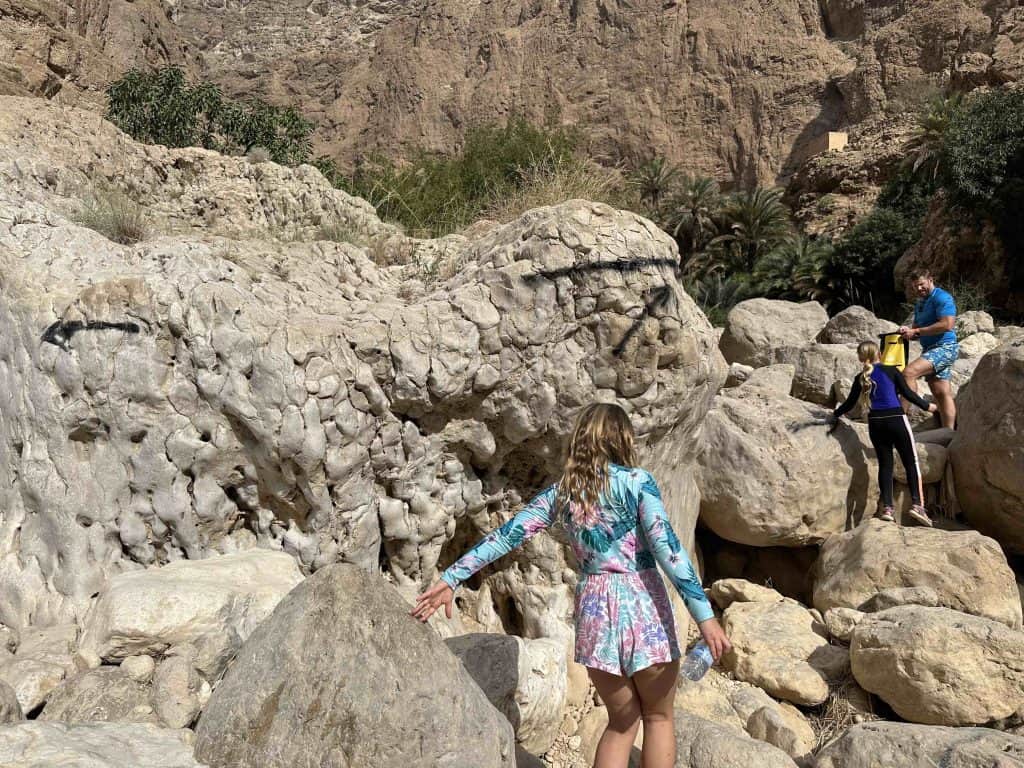
However, there’s no chance of getting lost. Just keep following the valley floor.
It took us about an hour to reach the main wadi pools. At this point you have to swim to progress further.
Swimming at Wadi Shab
You’ll have to excuse the quality of my pictures during our swim at Wadi Shab. They are all taken through a waterproof phone case (essential equipment for this wadi).
But I thought they were worth including to give you an idea of the challenge ahead of you.
You know you’ve reached the swimming area when you spot a ‘welcome’ sign that looks like it has seen much better days. It explains that you cannot walk from this point and you have to be a good swimmer to reach the cave at the end.
Having visited a few wadis now (and kicked ourselves for not being quite as prepared as we needed to be when we went to neighbouring Wadi Tiwi) we were prepared with waterproof bags and buoyancy aids for the kids.
My girls have both come on leaps and bounds with their swimming since we moved to Oman but when you are doing this kind of outdoor adventure extra precautions never hurt.
There’s plenty of space in the area around the first pool to leave any belongings you don’t want to take with you.
Please remember to pick them up, along with any empty water bottles and food packaging, when you leave. Littering is sadly a big problem in beauty spots like this.
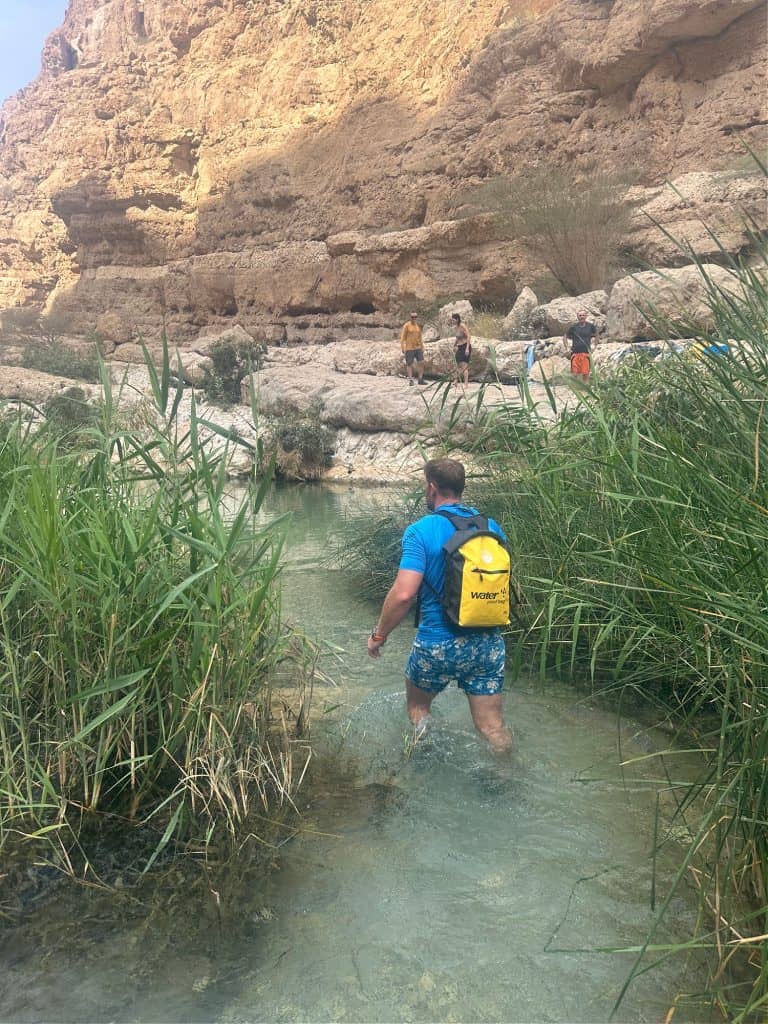
The swim from the first pool to where you enter to the Wadi Shab cave is a few hundred meters. There are sections where you can wade through the water, where the water flows ankle deep over shingle and parts where the bottom is nowhere in sight.
Take a look at my Wadi Shab Reel on Instagram that shares video from the swim.
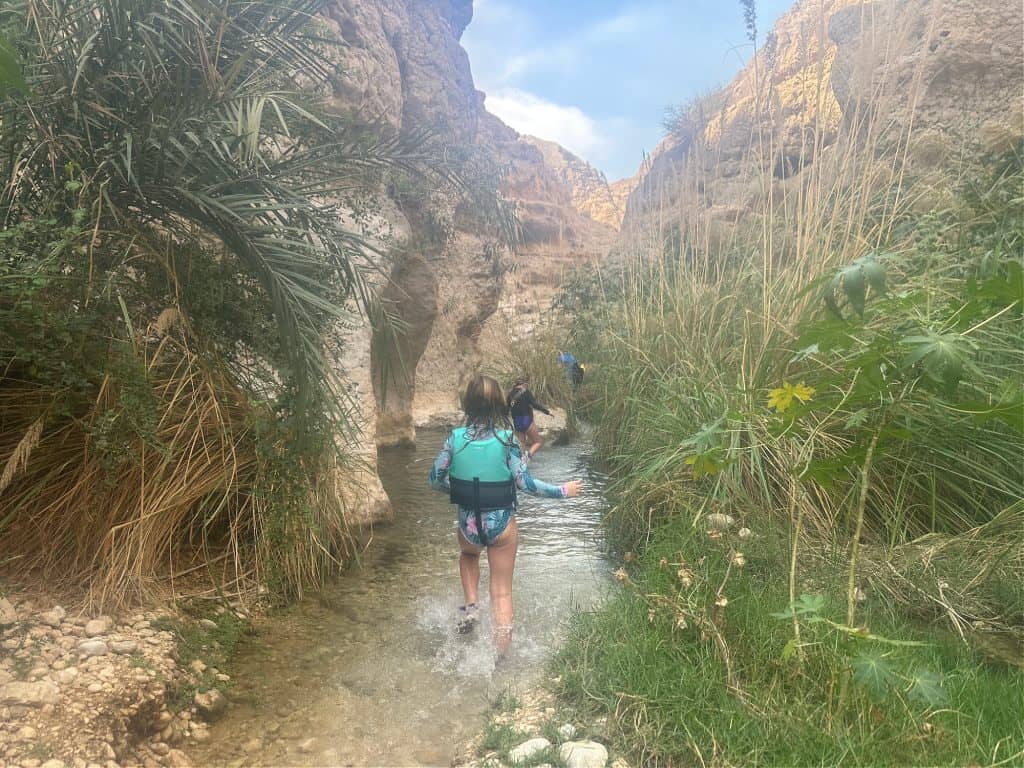
It’s also worth mentioning that there’s slippery algae on the rocks. Take it slowly in and out of the water.
Just before the final pool you will need to climb up over a small waterfall were it would be possible to hurt yourselves if not approached carefully.
This section was particularly slippery on the return trip when it was wet from the increased number of visitors arriving after us.
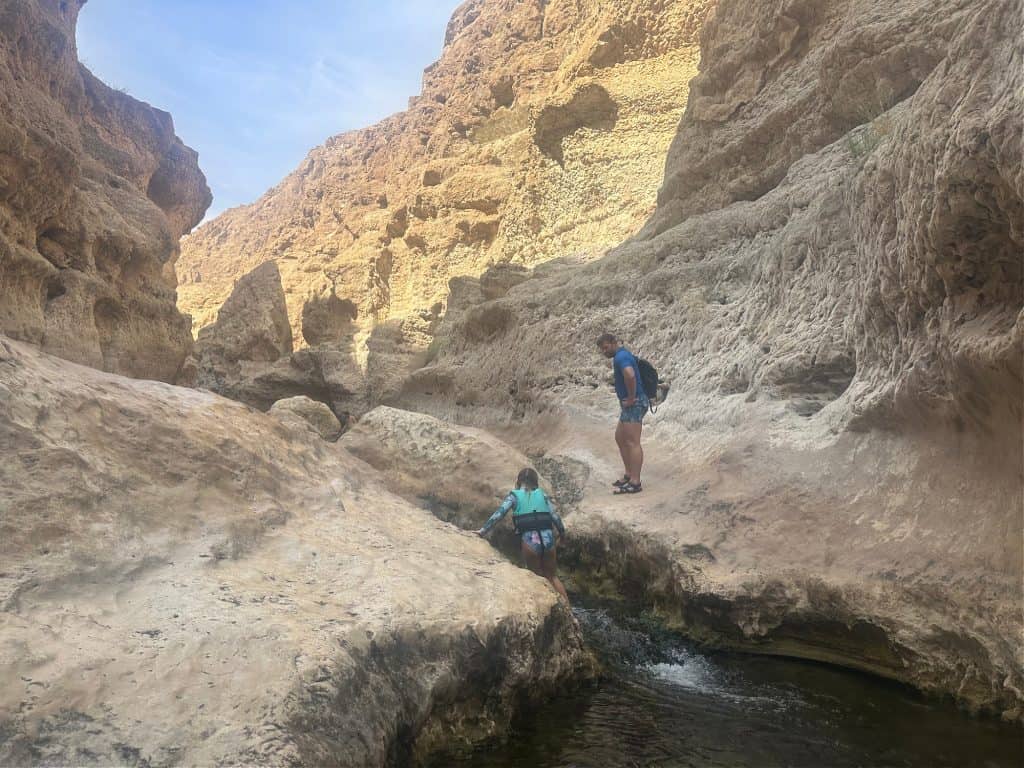
See my list of what to wear below for suggestions on footwear.
The Wadi Shab cave
If you make it to the end of the last deep pool you can experience Wadi Shab’s hidden cave. Be warned, this is not advisable if you experience claustrophobia.

The cave entrance only becomes clear as you approach because it is mostly underwater. There’s just a narrow opening above the waterline that isn’t much bigger than your head in some places.
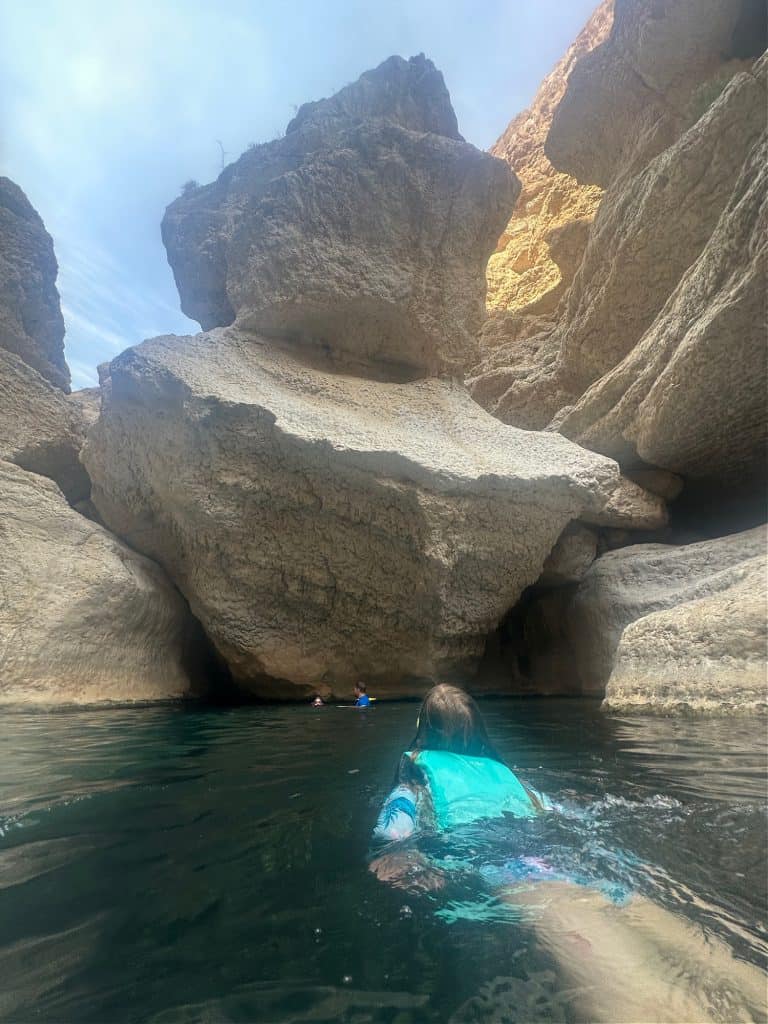
You won’t be able to touch the bottom as you enter the cave or inside it. As we felt below the water line the walls disappeared outwards and it became clear that we were floating at the top of a huge cavern.
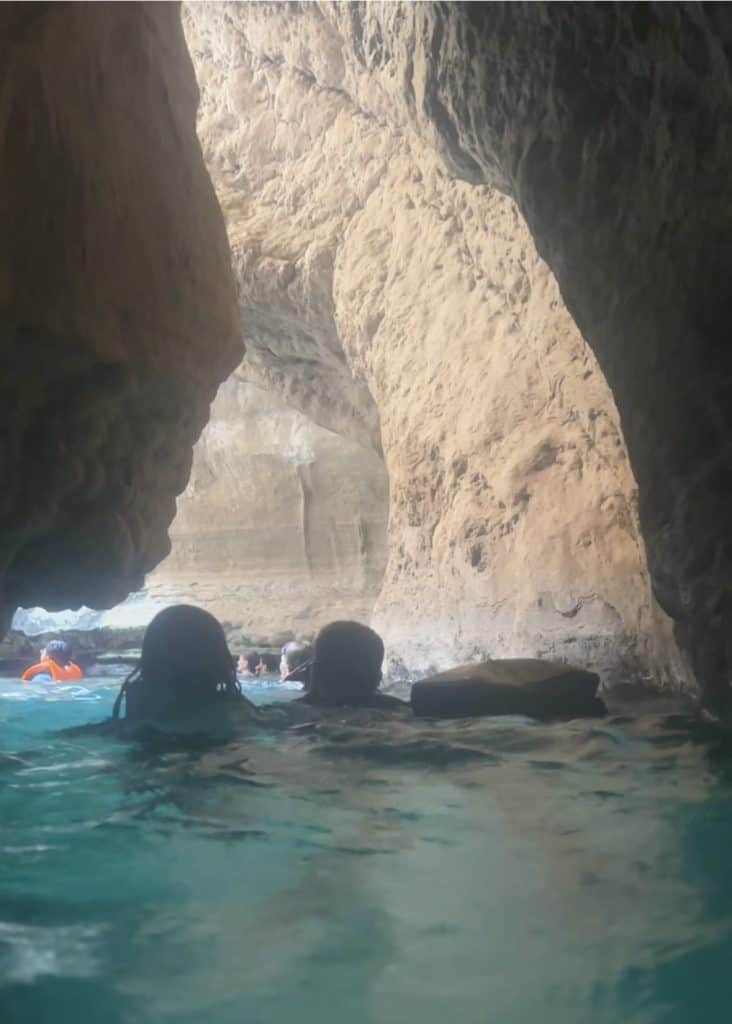
There were about 12 other people in the cave when we arrived, all taking it in turns to climb ropes up the mostly dry waterfall to jump back into the water.
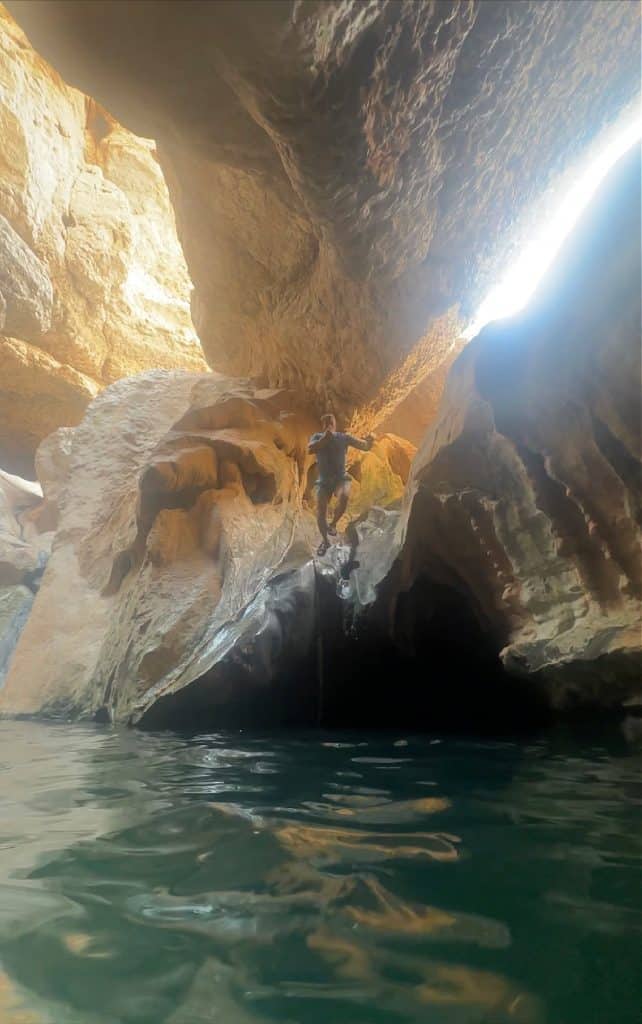
Mr Tin Box couldn’t resist a go and one of the local guides helped our two girls up to jump from a lower ledge.
To the right of the waterfall you can find a narrow channel that has been eaten into the rock around the back.
Making it to the cave was a real highlight for us. We’d recommend giving it a go but you need to come prepared with the right clothing and equipment.
What to wear at Wadi Shab
We’d recommend arriving at Wadi Shab wearing swimming costumes under your clothes as there’s nowhere to change when you reach the pools.
You could also slip on your swimwear in the public toilets in the car park if you don’t want to wear them during the drive to Wadi Shab.
Here’s the other things to wear during your visit:
Conservative outdoor clothing
Oman is a Muslim country where dressing conservatively is a legal requirement. In general you should wear clothes that cover upper arms and knees.
A short sleeve t-shirt and cropped workout leggings for women and a t-shirt and long shorts for men is totally acceptable for the hiking section of Wadi Shab.
When it came to the swim we wore rash vests with short sleeves* and swim shorts*. These can be worn underneath other clothing and also help to protect against the sun.
Sturdy shoes

We always wear walking sandals that we can use in water when we visit wadis. This saves carrying extra water shoes that are essential for stoney and slippery sections.
The girls and I all have KEEN shoes, which have grippy soles for walking and have been in and out of the water more times than I can count.
The kids currently have KEEN Unisex Kid’s Verano Open Toe Sandals* and I have had a pair of KEEN trail shoes for about four years now. They have been discontinued but are still going strong.
Here’s another KEEN outdoor sandal* that I know would work well as the girls have had smaller versions in the past. The kids always grow out of KEEN shoes before they wear them out, so we often pass them on.
Buoyancy aids for kids
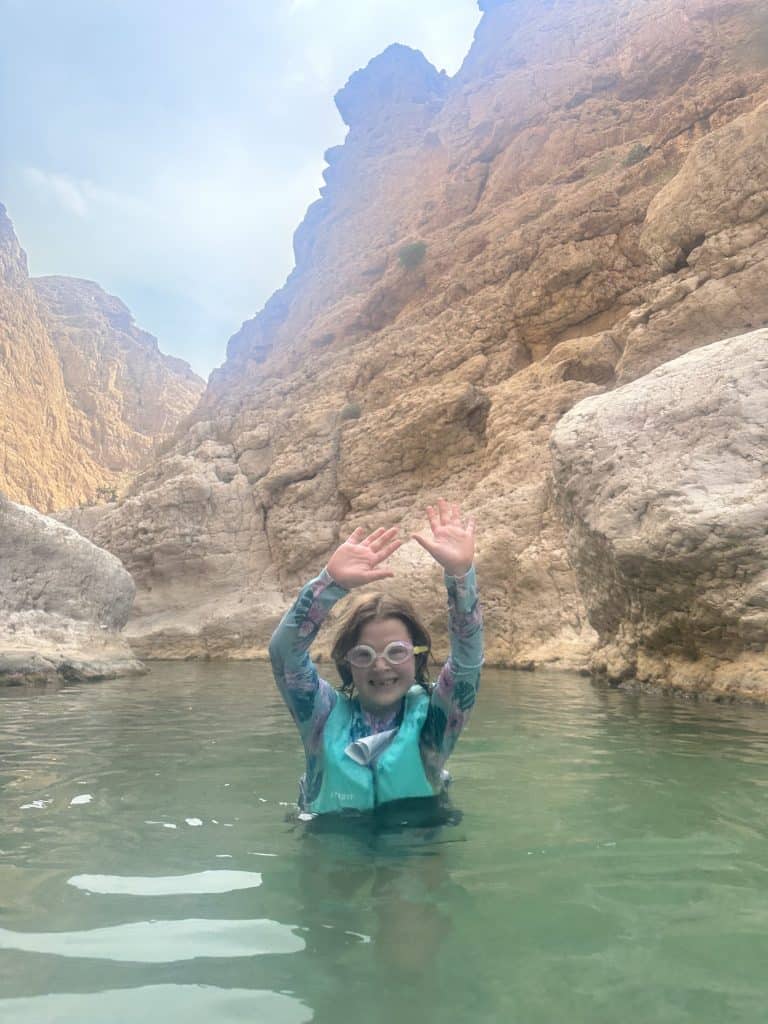
They’re not just for kids. All of the visitors on the organised tours that we saw were wearing buoyancy aids.
We decided to put our girls in their buoyancy aids despite them being fairly strong swimmers and I’m sure the tour guides were using the same logic. Accidents can happen quickly, particularly slip ups. So if you fall it’s much better that you float.
Your health and safety is your own responsibility whichever wadi you visit.
We brought one of the kids’ buoyancy aids with us from the UK and bought another at Decathlon in the Mall of Oman where they also sell adult buoyancy aids.
Mr Tin Box and I have Restubes* for paddle boarding but we didn’t use them at the wadi.
Other things to take to Wadi Shab
After visiting several wadis in Oman we’ve put together a list of suggested things to take along.
We’ve kicked ourselves a few times for forgetting obvious things and items that make the experience so much easier. But I think we’ve now got the definitive list.
If you don’t already have some of these essential items we’ve found the following shops good for outdoor gear:
- The Sultan Centre, various locations in Muscat
- Decathlon in the Mall of Oman
- Sun and Sand Sport in Avenues Mall, the Mall of Oman and City Centre Mall. There’s also an outlet shop in Markaz Al Bahja.
I’ve also included links below where you can order these things online if you’re able to plan far enough ahead.
Here are some wadi staples to bring with you:
Dry bag
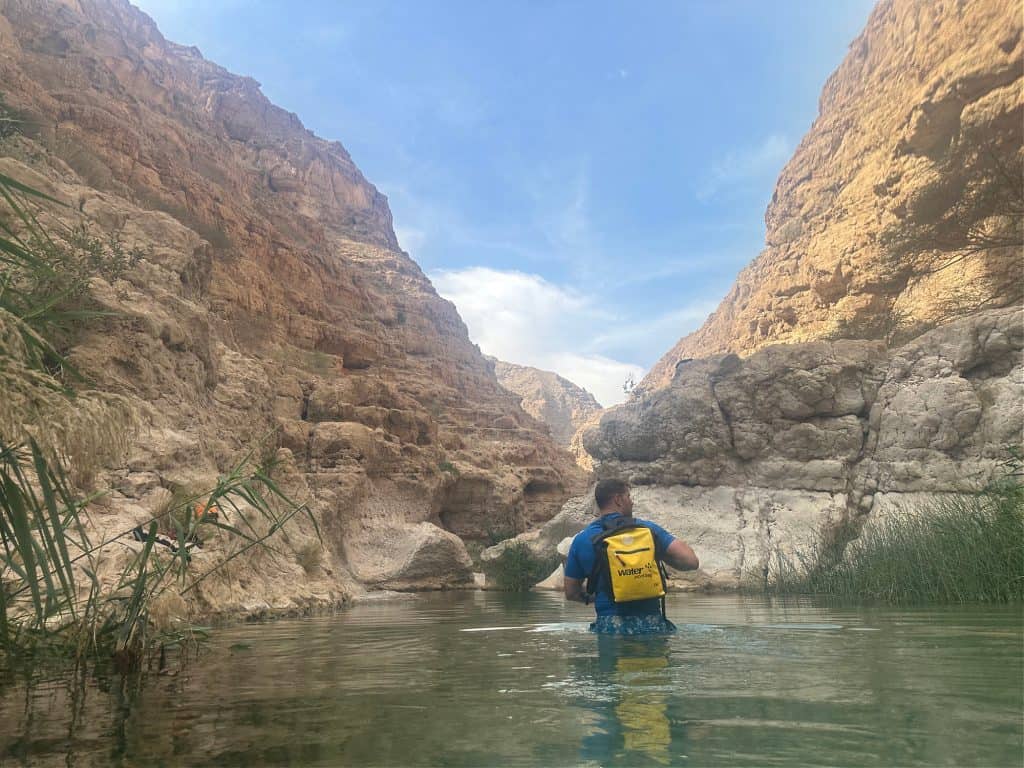
We have a rucksack that’s also a dry bag. We picked this up at a Sultan Centre shop in Muscat and we take it with us everywhere now.
It’s easy to carry and big enough for a light-weight towel, some snacks and water, goggles for the kids, and a first aid kit. It also doubles as a useful flotation device.
At Wadi Shab it meant that we didn’t need to leave any belongings at the first pool.
You can buy it online*.
If you forget a dry bag big enough just for your phone or wallet you can also buy these at the wadi car park.
Towels
Bring a microfibre towel*. It’s a good idea to dry off a bit when you leave the pools so you are less likely to slip on the rocky path back to the wadi entrance.
You need something small that won’t retain lots of water and become heavy on your return walk.
Sun glasses
There’s lots of shade to be found in the wadi but not all the time so protect your eyes with good sunglasses.
Sun cream
For exactly the same reasons as you need sunglasses, wear factor 50 sun cream on your face and body. Even in the shade you’ll be picking up rays.
Goggles
I’m not a fan of putting my face in the water intentionally but my kids love it. Goggles allow them a different perspective on wadis so we always bring theirs.
Change of clothes
In case you get your hiking clothes wet or dirty leave a spare set in your car.
Snacks and water
Where would us parents be without snacks for the kids?! Our go to snacks for hiking trips are apples and small packets of biscuits, which we can easily slip into our rucksack.
We often pack a picnic too as it means we can get food into the kids fast when we get back to the car. A cool box and ice blocks are handy for keeping food fresh in a hot vehicle.
Water
You’re going to need a lot of water, but won’t necessarily want to carry it all with you.
Make sure everyone has a small bottle of water for the hike and leave some chilling in your vehicle.
Tissues
I don’t go anywhere in Oman without a packet tissues. You never know if public lavatories will have any, especially in more rural areas where squat toilets and bum guns (hoses by the loo) are the norm.
First aid kit
Something else we rarely adventure without is our small first aid kit. This has plasters, including Compeeds, bug bite cream and Panadol (paracetamol). This is what we carry with us.
We have another first aid kit* including bandages in our car.
Facilities at the wadi
There’s a long tarmac car park and parking is free.
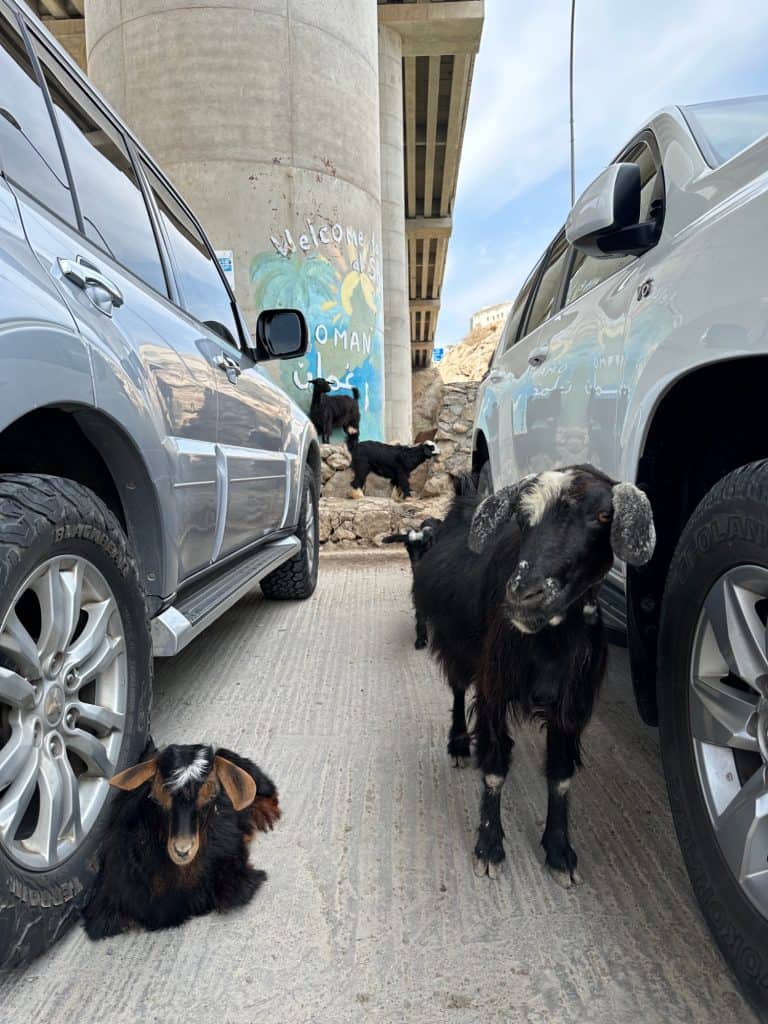
Be aware that the car park is a hang out for goats who are very forward, particularly if they think they can sniff out a snack. They will put their heads in bags and their bodies in your car if you don’t keep an eye on them.
At the end of the car park there’s a cafe with showers (you’ll pay a fee to use these). We didn’t stop at the cafe as we suspected it might be expensive. But if you are short on snacks or water it could prove very handy.
There’s free toilets towards the car park entrance. These have western style loos as well as a squat toilets. Bring your own toilet tissue. You can also change here.
Where is Wadi Shab?
Whether you are coming from Muscat or Sur it’s very easy to find Wadi Shab. It’s sign posted off Highway 17 one hour 45 minutes (170km) south from Muscat International Airport and 40 minutes north (50km) from Sur.
Look for signs for signs saying ‘Al Shab’.
The pin on this map is the public toilets at the entrance to the Wadi Shab car park.
Where to stay at Wadi Shab
We visited from where we live in Muscat but if you are holiday or an Oman road trip there are a few options for places to stay near Wadi Shab.
Wadi Ashab Chalets – adults only
This sea front guest house with private rooms and shared lounge is the closest accommodation to Wadi Shab – you can walk to the ferry in five minutes.
This is an adults only guest house but does offer rooms for up to five people.
Check availability at Wadi Ashab Chalets*.
Wadi Shab Guest House – family-friendly
This Omani-style villa accommodation is 1km from the wadi entrance, so a very easy drive to reach the wadi for when the ferry starts running.
It only offers double and twin rooms so if you are travelling with children you will have to book two rooms as they do not offer extra beds. However, it gets great reviews, has a swimming pool and is right on the beach.
Check availability at Wadi Shab Guest House*.
Tiwi Sunrise – family rooms
This hotel is located near the entrance to Wadi Tiwi and is a six minute drive from Wadi Shab.
It only has double rooms but you can request extra beds for children. These are free for children aged 12 and under but are subject to availability.
Tiwi Sunrise has a restaurant, swimming pool and is located on the beach.
Check availability at Tiwi Sunrise*.
Tiwi Beach Villa – a private villa
If you are travelling with a large group this beach front villa sleeps up to 10 people in three bedrooms with a shared bathroom.
It has its own private beach and swimming pool.
Check availability at Tiwi Beach Villa*.
Wild camping near Wadi Shab
Another option is to camp. Wild camping is very easy in Oman as you can do it anywhere out of sight of houses and a safe distance from roads.
You will however need a 4×4 to access most wild camping places in Oman.
Popular camping places near Wadi Shab are Pebble Beach and Fins Beach. You’ll find both just to the north of Tiwi.
More reading about Oman
We moved to Oman in 2022 and are loving getting to know our new, home.
Here’s some more posts I’ve written about Oman and expat life:
Check out the #TinBoxOman hashtag on Instagram to see more of our adventures.
Disclosure: this post contains affiliate links marked with *. If you click on one of these and make a purchase I may earn some commission. This does not affect the price you pay.

